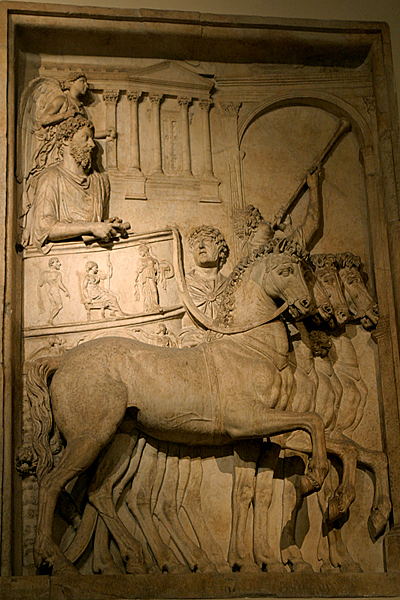

"The appearance of the horse that ought to be most preferred has been very beautifully described in the poetry of Virgil."
Pliny, Natural History (VIII.162)
"From the first, the foal of a noble breed steps higher in the fields and brings down his feet lightly. Boldly he leads the way, braves threatening rivers, entrusts himself to an untried bridge, and starts not at idle sounds. His neck is high, his head clean-cut, his belly short, his back plump, and his gallant chest is rich in muscles. Good colours are bay and grey; the worst, white and dun. Again, should he but hear afar the clash of arms, he cannot keep his place; he pricks up his ears, quivers in his limbs, and snorting rolls beneath his nostrils the gathered fire. His mane is thick and, as he tosses it, falls back on his right shoulder. A double ridge runs along his loins; his hoof scoops out the ground, and the solid horn gives it a deep ring."
Virgil, Georgics (III)
Smaller and more stocky than the contemporary Andalusian and Lusitano, the Roman horse needed hard hooves and strong joints to negotiate the turns and race successfully. Many must have been injured and yet others are recorded as having raced and won hundreds of times, those who were victorious being honorably put out to pasture.
Anthropomorphized, horses were imbued by the Romans with almost human characteristics.
"Horses harnessed to chariots in the circus unquestionably show that they understand the shouts of encouragement and applause. At the races in the circus forming part of the Secular Games of Claudius Caesar [AD 47] a charioteer of the Whites named Raven was thrown at the start, and his team took the lead and kept it by getting in the way of their rivals and jostling them aside and doing everything against them that they would have had to do with a most skilful charioteer in control, and as they were ashamed for human science to be beaten by horses, when they had completed the proper course they stopped dead at the chalk line."
Pliny, Natural History (VIII.159)
This relief is one of several that celebrate the victory of Marcus Aurelius over the German tribes and now is above the landing of the main staircase in the Palazzo dei Conservatori (Rome). Marcus Aurelius, preceded by a lector and flutist and attended by a winged Victory, is about to pass through a triumphal arch. One sees the strong chests of the horses and the much heavier triumphal chariot. For all the pomp, the emperor was skeptical of such fame.
"And consider, too, the life lived by others in olden time, and the life of those who will live after thee, and the life now lived among barbarous nations, and how many know not even thy name, and how many will soon forget it, and how they who perhaps now are praising thee will very soon blame thee, and that neither a posthumous name is of any value, nor reputation, nor anything else."
Meditations (IX)